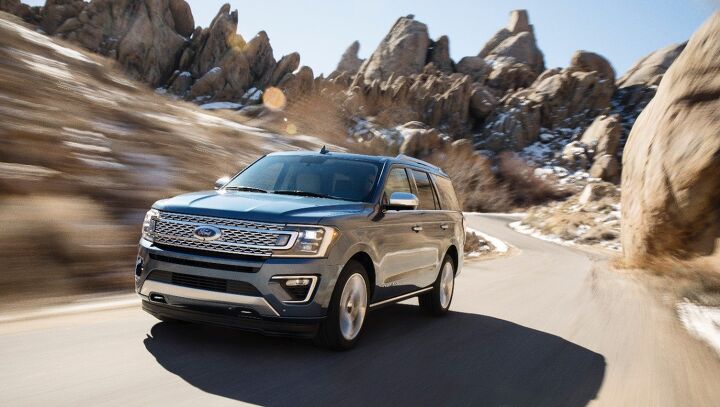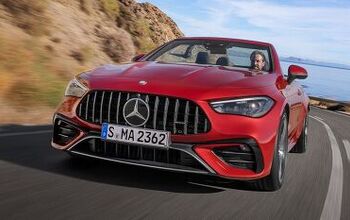There's a Ford (SUV) in Your Future: Brand Goes Big on Utilities, Lincoln Might Go All In

The future is electric, industry leaders tell us, but it will also have room for cargo. Lots and lots of it.
In announcing its near-future product plans on Thursday, Ford Motor Company promised the replacement of “more than 75 percent of its current portfolio” by 2020, with sport utility vehicles filling the sales void created by declining car volume. By the start of the next decade, only 14 percent of sales will come from cars, Ford predicts.
Meanwhile, at Lincoln, there’s good reason to believe the automaker’s luxury brand might enter the coming decade completely carless.
Ford detailed the new product offensive via a flurry of media releases and through a media chat with top brass at the automaker’s product development center. As we told you yesterday, the changes mean eight SUVs in Ford’s lineup, up from today’s six. A baby off-roader joins the reborn Bronco, due out in 2020.
Going forward, Ford plans to use five modular architectures for all of its vehicles: body-on-frame, front-wheel-drive unibody, rear-wheel-drive unibody, commercial van unibody, and battery electric vehicle. These architectures make up 70 percent of the vehicle’s engineering, with the remainder amounting to a unique skin for different models.
Ford’s aiming for a product development cycle (paper to showroom) that’s 20 percent shorter than in the past. This stems from its promise to not only deliver new products in a speedier fashion, but also find $4 billion in engineering efficiencies.
According to Jim Farley, Ford’s head of global markets, every new or redesigned SUV will now come with a hybrid variant. This could mean a conventional hybrid (Ford says it has found a cheaper way of doing it), a plug-in version, or a combination of both.
“They’re an accepted, reliable technology, and we want to make them as emotional and valuable as the desirable EcoBoost,” Farley said.
Ford wants to go head to head with Jeep in some areas, while distancing itself from the off-road brand in other ways. Hybrids, for one thing, but also performance. We’ve already seen Ford come out with an Edge ST, and the more capacious Explorer — which goes rear-drive for 2020 — will soon see its own high-horsepower ST variant.
“We don’t just want to be in the generic SUV business. We want to be either in the performance or in the high-speed, off-road business,” Farley said.
Mentioning Jeep and Land Rover, Farley added, “Both of these vehicles are for a growing group of people who want to simplify their life and get out there with their family and friends. For Jeep, that’s rock-crawling in Moab. For Ford, our people want true off-road vehicles that are comfortable at high speeds. They don’t want SUVs that look like doomsday vehicles or have spartan, government-issued interiors.”
(Hmmm… we’re inclined to believe there’s more than a few prospective Ford buyers who like the doomsday vehicle look.)
The Lincoln brand, which has recently fallen on hard sales times, stands to see two new SUV models by 2020, including the Explorer-based Aviator. The MKX undergoes a name change (“Nautilus”) for 2019. Four more utility vehicles will appear after 2020, Farley said, without going into specifics.
Given that the Ford Fusion-based MKZ appears doomed, and the flagship Continental along with it, this could mean an all-crossover-and-SUV lineup for the brand that, until the late 90s, had zero such vehicles.
In the fledgling electric vehicle class, Ford’s plans have changed. It’s now aiming for a 50 percent decrease in capital investment and a 30 percent increase in labor efficiency, all in the hopes of making an affordable vehicle that can also turn a profit. Six Ford EVs are in the pipeline for the 2020-2022 period.
Amid all this news of off-roaders, hybrids, and battery-powered vehicles, one long-running but barely thought-of model just saw a reprieve. The E-Series, once known as the Econoline, still exists in a cutaway bodystyle for commercial buyers. While the Transit and smaller Transit Connect have stolen the model’s van sales, Ford claims the E-Series will soldier on into the 2020s. A new Windsor-built 7.0-liter V8 engine is in the works to replace the ancient 6.8-liter Triton V10.
[Source: Automotive News] [Images: Ford]

More by Steph Willems
Latest Car Reviews
Read moreLatest Product Reviews
Read moreRecent Comments
- Rover Sig 2021 Jeep Grand Cherokee Limited, like my previous JGC's cheap to keep (essentially just oil, tires) until recent episode of clunking in front suspension at 50K miles led to $3000 of parts replaced over fives visits to two Jeep dealers which finally bought a quiet front end. Most expensive repair on any vehicle I've owned in the last 56 years.
- Bob Hey Tassos, have you seen it with top down. It's a permanent roll bar so if it flips no problem. It's the only car with one permanently there. So shoots down your issue. I had a 1998 for 10 years it was perfect, but yes slow. Hardly ever see any of them anymore.
- 3-On-The-Tree 2007 Toyota Sienna bedsides new plugs, flat tire on I-10 in van Horn Tx on the way to Fort Huachuca.2021 Tundra Crewmax no issues2021 Rav 4 no issues2010 Corolla I put in a alternator in Mar1985 Toyota Land Cruiser FJ60 280,000mi I put in a new radiator back in 08 before I deployed, did a valve job, new fuel and oil pump. Leaky rear main seal, transmission, transfer case. Rebuild carb twice, had a recall on the gas tank surprisingly in 2010 at 25 years later.2014 Ford F159 Ecoboost 3.5L by 80,000mi went through both turbos, driver side leaking, passenger side completely replaced. Rear min seal leak once at 50,000 second at 80,000. And last was a timing chain cover leak.2009 C6 Corvette LS3 Base, I put in a new radiator in 2021.
- ChristianWimmer 2018 Mercedes A250 AMG Line (W177) - no issues or unscheduled dealer visits. Regular maintenance at the dealer once a year costs between 400,- Euros (standard service) to 1200,- Euros (major service, new spark plugs, brake pads + TÜV). Had one recall where they had to fix an A/C hose which might become loose. Great car and fun to drive and very economical but also fast. Recently gave it an “Italian tune up” on the Autobahn.
- Bd2 Lexus is just a higher trim package Toyota. ^^


































Comments
Join the conversation
How does the world's largest and most profitable car maker Toyota manage to successful sell cars, trucks, and SUVs. Unlike Ford, Toyota has all its bases covered. Toyota must laugh at Ford's inefficiencies.
"“We don’t just want to be in the generic SUV business. We want to be either in the performance or in the high-speed, off-road business,” Farley said." Jeebus, Jim do you think before you speak? Unless you're building an X-34 landspeeder no vehicle is "high speed" when offroad, nor are offroad vehicles built for "performance". You planning to sell us an Expedition we can track Jim? Don't conflate what makes a Mustang cool with what makes say your F-150 cool, you sound foolish. "Meanwhile, at Lincoln, there’s good reason to believe the automaker’s luxury brand might enter the coming decade completely carless." Oh so no MKEdge or MKEscape? Cool! MKBronco, MKExplorerRWD and Navi sounds decent to me. "The MKX undergoes a name change (“Nautilus”) for 2019." Weak. Get rid of it if you're going all truck on us.